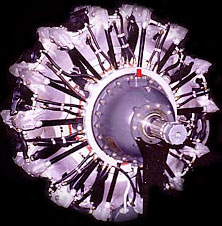|
 The R-1830 was produced in greater
numbers than any other aircraft engine ever built. By the time the last example rolled off
the production line approximately 178,000 Twin Wasps of all types had been made. Pratt
& Whitney augmented its output of the engine by granting license production to Buick,
Chevrolet, Commonwealth Aircraft in Australia and, after World War II, to Flygmotorbolaget
in Sweden. The Twin Wasp design began in 1931 under the guidance of legendary P & W
engineer Luke Hobbs. This twin row radial incorporated 14 cylinders in two rows of seven,
mounted to a forged aluminum crankcase. Liberal amounts of magnesium were used in the
design to save weight, and special attention was given to the engine mounts to reduce
vibration. For most of the 1930s the R-1830 was the largest U.S. engine under development.
Improved fuels,
supercharger technology and cooling processes yielded a power increase from 800 hp in the
R-1830-1 to 1200 hp in the -92 series. The R-1830-76 became the first engine in history
with two-stage supercharging, developed for use in the U.S. Navy's F4F-3 Wildcat.
The R-1830 was produced in greater
numbers than any other aircraft engine ever built. By the time the last example rolled off
the production line approximately 178,000 Twin Wasps of all types had been made. Pratt
& Whitney augmented its output of the engine by granting license production to Buick,
Chevrolet, Commonwealth Aircraft in Australia and, after World War II, to Flygmotorbolaget
in Sweden. The Twin Wasp design began in 1931 under the guidance of legendary P & W
engineer Luke Hobbs. This twin row radial incorporated 14 cylinders in two rows of seven,
mounted to a forged aluminum crankcase. Liberal amounts of magnesium were used in the
design to save weight, and special attention was given to the engine mounts to reduce
vibration. For most of the 1930s the R-1830 was the largest U.S. engine under development.
Improved fuels,
supercharger technology and cooling processes yielded a power increase from 800 hp in the
R-1830-1 to 1200 hp in the -92 series. The R-1830-76 became the first engine in history
with two-stage supercharging, developed for use in the U.S. Navy's F4F-3 Wildcat.
While the Twin Wasp was used in fighters like the Seversky P-35 and Curtiss P-36,
it was best known and a powerplant for multiengine bombers and transports. Included on the
list is the Consolidated B-24 Liberator/PB4Y-2 Privateer series which was the most
produced U.S. aircraft in history. Other users included the Douglas C-47 Skytrain and the
PBY Catalina flying boat, both of which used a pair of R-1830-92 engines.
[Back to the OA-10A page]
|

